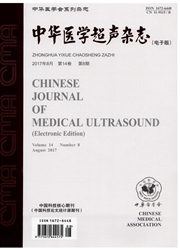

 中文摘要:
中文摘要:
目的应用超声三维斑点追踪成像(3D-STI)技术评价肥厚型心肌病(HCM)左心室扭转运动特征。方法收集非梗阻性HCM患者28例(HCM组)及正常志愿者25名(对照组),应用3D-STI获取并定量比较其左心室收缩及舒张末期容积、射血分数、质量和室壁基底水平及心尖水平收缩期旋转角峰值、局部扭矩峰值,左心室整体及局部收缩期扭转角峰值、左心室整体收缩期扭矩峰值等参数。结果HCM组左心室收缩及舒张末期容积减小,左心室质量增加,左心室壁基底水平收缩期旋转角峰值和局部扭矩峰值、左心室整体收缩期扭转角峰值和扭矩峰值以及室间隔基底水平和心尖水平局部扭转角峰值均大于对照组(P均〈0.05),而左心室射血分数、心尖水平收缩期旋转角峰值和局部扭矩峰值差异均无统计学意义(P均〉O.05)。结论HCM患者左心室整体及部分节段(室间隔基底水平和心尖水平)收缩期扭转运动能力较正常人增强。左心室整体收缩期扭转角峰值能更好地反映HCM的异常心肌力学状态。
 英文摘要:
英文摘要:
Objective To assess left ventricular twist in patients with hypertrophic cardiomyopathy (HCM) using three- dimensional speckle tracking imaging (3D-STI). Methods Twenty-eight non-obstructive HCM patients (HCM group) and 25 healthy volunteers (control group) were enrolled. The apical three-dimensional full-volume dynamic images of left ven- tricle were acquired and stored. The anatomical and mechanical parameters were derived using 3D-STI on-line analysis soft- ware, including left ventricle end-systolic volume (LVESV), left ventricle end-diastolic volume (LVEDV), left ventricle e- jection fraction (LVEF), left ventricle mass (LVM), peak systolic rotation On basal plane (Prot-base) and apical plane (Prot-ap), peak systolic torsion_regional on basal plane (Ptor-base) and apical plane (Ptor-ap), peak systolic twist (Ptw) of the global and 16 segments, as well as the global peak systolic torsion (Ptor). The parameters of the two groups were compared. Results Compared with those of control group, LVEDV and LVESV significantly decreased, while LVM sig- nificantly increased (all P〈0.05) in HCM group. There was no significant difference of LVEF between the two groups (P〉0.05). Prot-base, Ptor-base, the global Ptw of the left ventricular and the basal and apical segments of interventricu- lar septum, Ptor increased significantly in HCM group (all P〈0. 05). There was no significant difference of Prot-ap and Ptor-ap between the two groups (all P〉0.05). Conclusion The systolic twist of left ventricular global and the basal and apical segments of interventricular septum in patients with HCM increase significantly. The global Ptw of left ventricle might be suitable to reflect the dysfunction in patients with HCM.
 同期刊论文项目
同期刊论文项目
 同项目期刊论文
同项目期刊论文
 期刊信息
期刊信息
